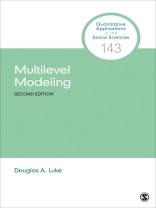Multilevel Modeling is a concise, practical guide to building models for multilevel and longitudinal data. Author Douglas A. Luke begins by providing a rationale for multilevel models; outlines the basic approach to estimating and evaluating a two-level model; discusses the major extensions to mixed-effects models; and provides advice for where to go for instruction in more advanced techniques. Rich with examples, the
Second Edition expands coverage of longitudinal methods, diagnostic procedures, models of counts (Poisson), power analysis, cross-classified models, and adds a new section added on presenting modeling results. A website for the book includes the data and the statistical code (both R and Stata) used for all of the presented analyses.
Tabela de Conteúdo
Series Editor′s Introduction
About the Author
Preface
1. The Need for Multilevel Modeling
Background and Rationale
Theoretical Reasons for Multilevel Models
Statistical Reasons for Multilevel Models
Scope of Book
Online Book Resources
2. Planning a Multilevel Model
The Basic Two-Level Multilevel Model
The Importance of Random Effects
Classifying Multilevel Models
3. Building a Multilevel Model
Introduction to Tobacco Voting Data Set
Assessing the Need for a Multilevel Model
Model-building Strategies
Estimation
Level-2 Predictors and Cross-Level Interactions
Hypothesis Testing
4. Assessing a Multilevel Model
Assessing Model Fit and Performance
Estimating Posterior Means
Centering
Power Analysis
5. Extending the Basic Model
The Flexibility of the Mixed-Effects Model
Generalized Models
Three-level Models
Cross-classified Models
6. Longitudinal Models
Longitudinal Data as Hierarchical: Time Nested Within Person
Intra-individual Change
Inter-individual Change
Alternative Covariance Structures
7. Guidance
Recommendations for Presenting Results
Useful Resources
References
Sobre o autor
Douglas A. Luke is Professor and Director of the Center for Public Health Systems Science at the Brown School at Washington University in St. Louis. Dr. Luke is a leading researcher in the areas of public health policy, imple- mentation science, and systems science. Most of the work that Dr. Luke di- rects at the Center focuses on the evaluation, dissemination, and implemen- tation of evidence-based public health policies. During the past decade, Dr. Luke has worked on applying systems science methods to important public health problems, especially social network analysis. He has published two systems












